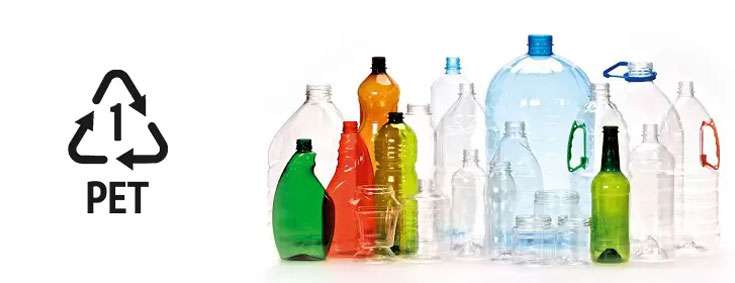PET or PETE stands for Polyethylene terephthalate, also known as polyester. In fact it is a clear, strong and lightweight plastic that is used for packaging food and beverages, especially fruit juices, water bottle, etc.
All one-liter and 2-liter bottles of beverages in the United States are made of PET.
It is also used to pack sauces, oils, and sanitary products such as mouthwashes, soaps, hand lotions, and even tennis balls. Special grade PET is used for dishes that are heated in the oven or microwave.
The main constituents of PET are ethylene glycol and terephthalic acid, which combine to form a polymer chain.
PET strands are extruded like spaghetti, cooled and cut into small balls. These balls are then heated and easily extruded or molded into any shape.
History of PET
PET was first synthesized in the United States in the mid-1940s by several chemists looking for synthetic fibers.
Currently, more than half of the world's synthetic fibers are made of PET, which is called "polyester". But when used for other utensils and utensils, it is called PET or PET resin.
In the late 1950s, researchers used stretching a PET sheet in two directions for use in the film, photography, and packaging industries.
In the early 1970s, this technology was used for impact molding of PET in bottles. In fact, the first PET bottle was produced and registered in 1973.
Global PET Safety
PET has been approved by the FDA for food and beverage contact worldwide, and this safety has been repeatedly confirmed by physicians, scientists, and extensive studies over 30 years.
PET does not contain harmful substances such as bisphenol A (BPA) or phthalates, which are used as lubricants. Due to its unique properties, it is rapidly becoming the preferred packaging material for food and beverages in the world.
It does not react with food and therefor resistant to microbes and does not decompose. (resistant to attack by micro organisms) Also light in weight and easy to transport, are other features of this material.
Recyclability of PET
PET is one of the most recyclable plastics in the United States and around the world. PET is easily identified in a triangular code. No other plastic contains that code.
PET can be decomposed by chemical decomposition or melted into its constituents and reused to make new resins.
Sustainability
PET has a very low consumption, although it is derived from raw materials such as crude oil and natural gas. It has a very good stability compared to glass, aluminum and other materials.
When recycled, its stability is even higher because 40% of PET energy consumption is trapped in raw materials that can be used through recycling.
High strength of PET
Due to its light weight, PET allows more products to be delivered in less packaging and therefore less fuel to be transported. During the years since PET production, it has become one of the most widely used and reliable materials. In the world has become.



